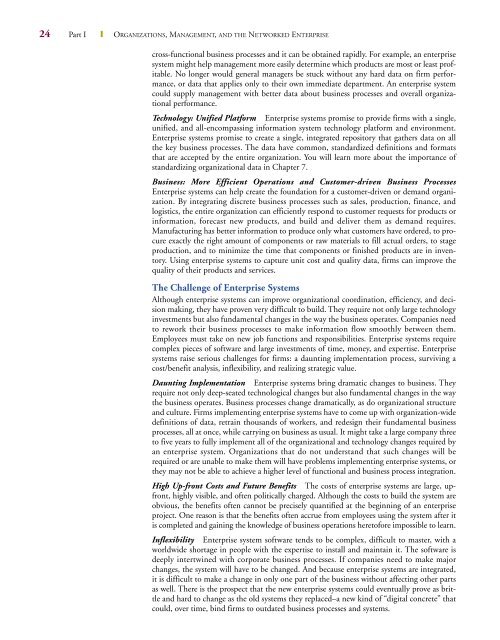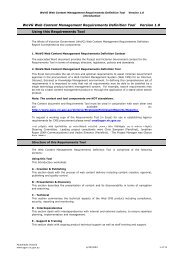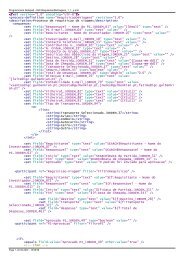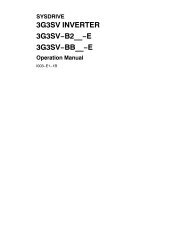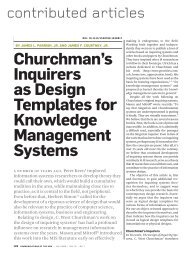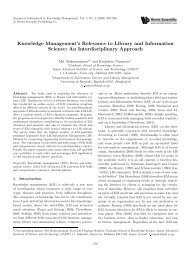2 Information Systems in the Enterprise - Main Web
2 Information Systems in the Enterprise - Main Web
2 Information Systems in the Enterprise - Main Web
Create successful ePaper yourself
Turn your PDF publications into a flip-book with our unique Google optimized e-Paper software.
24 Part I ❙ ORGANIZATIONS, MANAGEMENT, AND THE NETWORKED ENTERPRISE<br />
cross-functional bus<strong>in</strong>ess processes and it can be obta<strong>in</strong>ed rapidly. For example, an enterprise<br />
system might help management more easily determ<strong>in</strong>e which products are most or least profitable.<br />
No longer would general managers be stuck without any hard data on firm performance,<br />
or data that applies only to <strong>the</strong>ir own immediate department. An enterprise system<br />
could supply management with better data about bus<strong>in</strong>ess processes and overall organizational<br />
performance.<br />
Technology: Unified Platform <strong>Enterprise</strong> systems promise to provide firms with a s<strong>in</strong>gle,<br />
unified, and all-encompass<strong>in</strong>g <strong>in</strong>formation system technology platform and environment.<br />
<strong>Enterprise</strong> systems promise to create a s<strong>in</strong>gle, <strong>in</strong>tegrated repository that ga<strong>the</strong>rs data on all<br />
<strong>the</strong> key bus<strong>in</strong>ess processes. The data have common, standardized def<strong>in</strong>itions and formats<br />
that are accepted by <strong>the</strong> entire organization. You will learn more about <strong>the</strong> importance of<br />
standardiz<strong>in</strong>g organizational data <strong>in</strong> Chapter 7.<br />
Bus<strong>in</strong>ess: More Efficient Operations and Customer-driven Bus<strong>in</strong>ess Processes<br />
<strong>Enterprise</strong> systems can help create <strong>the</strong> foundation for a customer-driven or demand organization.<br />
By <strong>in</strong>tegrat<strong>in</strong>g discrete bus<strong>in</strong>ess processes such as sales, production, f<strong>in</strong>ance, and<br />
logistics, <strong>the</strong> entire organization can efficiently respond to customer requests for products or<br />
<strong>in</strong>formation, forecast new products, and build and deliver <strong>the</strong>m as demand requires.<br />
Manufactur<strong>in</strong>g has better <strong>in</strong>formation to produce only what customers have ordered, to procure<br />
exactly <strong>the</strong> right amount of components or raw materials to fill actual orders, to stage<br />
production, and to m<strong>in</strong>imize <strong>the</strong> time that components or f<strong>in</strong>ished products are <strong>in</strong> <strong>in</strong>ventory.<br />
Us<strong>in</strong>g enterprise systems to capture unit cost and quality data, firms can improve <strong>the</strong><br />
quality of <strong>the</strong>ir products and services.<br />
The Challenge of <strong>Enterprise</strong> <strong>Systems</strong><br />
Although enterprise systems can improve organizational coord<strong>in</strong>ation, efficiency, and decision<br />
mak<strong>in</strong>g, <strong>the</strong>y have proven very difficult to build. They require not only large technology<br />
<strong>in</strong>vestments but also fundamental changes <strong>in</strong> <strong>the</strong> way <strong>the</strong> bus<strong>in</strong>ess operates. Companies need<br />
to rework <strong>the</strong>ir bus<strong>in</strong>ess processes to make <strong>in</strong>formation flow smoothly between <strong>the</strong>m.<br />
Employees must take on new job functions and responsibilities. <strong>Enterprise</strong> systems require<br />
complex pieces of software and large <strong>in</strong>vestments of time, money, and expertise. <strong>Enterprise</strong><br />
systems raise serious challenges for firms: a daunt<strong>in</strong>g implementation process, surviv<strong>in</strong>g a<br />
cost/benefit analysis, <strong>in</strong>flexibility, and realiz<strong>in</strong>g strategic value.<br />
Daunt<strong>in</strong>g Implementation <strong>Enterprise</strong> systems br<strong>in</strong>g dramatic changes to bus<strong>in</strong>ess. They<br />
require not only deep-seated technological changes but also fundamental changes <strong>in</strong> <strong>the</strong> way<br />
<strong>the</strong> bus<strong>in</strong>ess operates. Bus<strong>in</strong>ess processes change dramatically, as do organizational structure<br />
and culture. Firms implement<strong>in</strong>g enterprise systems have to come up with organization-wide<br />
def<strong>in</strong>itions of data, retra<strong>in</strong> thousands of workers, and redesign <strong>the</strong>ir fundamental bus<strong>in</strong>ess<br />
processes, all at once, while carry<strong>in</strong>g on bus<strong>in</strong>ess as usual. It might take a large company three<br />
to five years to fully implement all of <strong>the</strong> organizational and technology changes required by<br />
an enterprise system. Organizations that do not understand that such changes will be<br />
required or are unable to make <strong>the</strong>m will have problems implement<strong>in</strong>g enterprise systems, or<br />
<strong>the</strong>y may not be able to achieve a higher level of functional and bus<strong>in</strong>ess process <strong>in</strong>tegration.<br />
High Up-front Costs and Future Benefits The costs of enterprise systems are large, upfront,<br />
highly visible, and often politically charged. Although <strong>the</strong> costs to build <strong>the</strong> system are<br />
obvious, <strong>the</strong> benefits often cannot be precisely quantified at <strong>the</strong> beg<strong>in</strong>n<strong>in</strong>g of an enterprise<br />
project. One reason is that <strong>the</strong> benefits often accrue from employees us<strong>in</strong>g <strong>the</strong> system after it<br />
is completed and ga<strong>in</strong><strong>in</strong>g <strong>the</strong> knowledge of bus<strong>in</strong>ess operations heretofore impossible to learn.<br />
Inflexibility <strong>Enterprise</strong> system software tends to be complex, difficult to master, with a<br />
worldwide shortage <strong>in</strong> people with <strong>the</strong> expertise to <strong>in</strong>stall and ma<strong>in</strong>ta<strong>in</strong> it. The software is<br />
deeply <strong>in</strong>tertw<strong>in</strong>ed with corporate bus<strong>in</strong>ess processes. If companies need to make major<br />
changes, <strong>the</strong> system will have to be changed. And because enterprise systems are <strong>in</strong>tegrated,<br />
it is difficult to make a change <strong>in</strong> only one part of <strong>the</strong> bus<strong>in</strong>ess without affect<strong>in</strong>g o<strong>the</strong>r parts<br />
as well. There is <strong>the</strong> prospect that <strong>the</strong> new enterprise systems could eventually prove as brittle<br />
and hard to change as <strong>the</strong> old systems <strong>the</strong>y replaced–a new k<strong>in</strong>d of “digital concrete” that<br />
could, over time, b<strong>in</strong>d firms to outdated bus<strong>in</strong>ess processes and systems.


